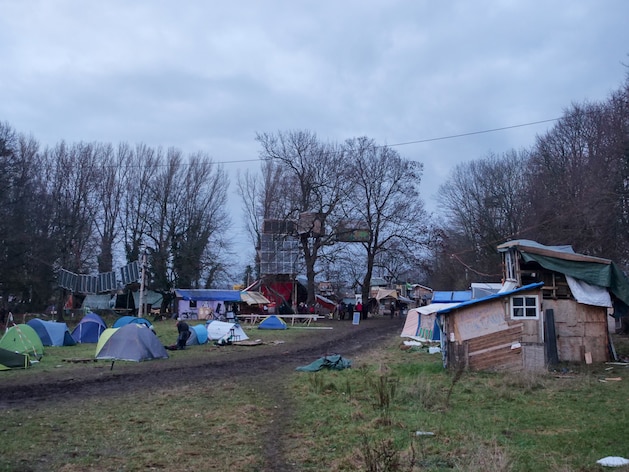The coal village of Lützerath is about to be cleared so that the energy company RWE can mine the coal underneath. Climate protectors and activists have a plan to prevent this – and are confident.
The activists in Lützerath announced Day X a week ago, now things are getting serious. They still attach wooden slats to the wooden huts, photovoltaic panels in the center of the improvised camp adorn the backdrop. One group carries a wooden module through the mud, while further ahead in the direction of the police line, others prepare the barricades.
Zora Fotidou still finds it difficult to grasp that this backdrop, the entire infrastructure that has grown over time, will soon give way to RWE’s hunger for coal. According to their own statements, the police want to start clearing the area as early as the middle of the week. “In the last few days I’ve developed quite a bit of confidence,” says the spokeswoman for the “Lützerath Lebt” group.
The solidarity and encouragement from outside are remarkable. Since the weekend, the number of local people has increased from an estimated 700 to more than 1,000, she notes. “I can’t imagine how that can work,” says Fotidou about the upcoming eviction.
Although the police have not yet enforced the ban on staying in and entering Lützerath, which has been in effect since December 23, 2022, there have already been clashes with the climate activists. The fact that the law enforcement officers cleared the first barricades and set up the parking lot in the previous week, Fotidou sees in contradiction to the announcement that the area will only be fenced off and then cleared from January 10th: “That is the opposite of good communication and de-escalation.”
In addition, officials had used batons and pepper spray for no reason at the weekend. “It was an attempt to demonstrate power – it failed,” she comments. The police, in turn, complained about violence on the part of the demonstrators, including throwing stones.
In the coal village, the squatters are preparing for further police operations. Mountaineering equipment, painter’s smocks, disguises, tree houses, monopods and tripods bring back memories of past protests of a similar nature. The activists have already gained experience and achieved success in the Hambacher and Dannenröder forest. Fotidou also feeds her confidence from this. After Hambi and Danni, Lützi should now be defended.
In this effort, time is working against the police and the energy company, notes the group spokeswoman. The clearing period stipulated in the Nature Conservation Act ends at the end of February, which means that the trees should no longer be felled. “At best, this is a step towards preserving Lützerath,” says Fotidou.
Meanwhile, Aachen’s chief of police, Dirk Weinspach, has always emphasized that the evacuation must be legally secure after the debacle in the Hambach Forest. But that is obviously not clear, even after the upcoming judgment of the OVG-Münster. In an interview with “t-online”, Thomas Schomerus, professor of public law at Leuphana University, recently reported constitutional concerns.
Because the general decree of the Heinsberg district is based on paragraph 48 of the Coal Power Generation Termination Act, which has since been amended. He attested that the Garzweiler II lignite mine was of vital importance in terms of energy management and politics. “The old paragraph was unconstitutional in my opinion,” Schomerus told the portal. It was based on a key decision from North Rhine-Westphalia, which in 2016 still assumed that coal would be phased out by 2045. That has since been brought forward to 2035. In a compromise with the black-green state government, RWE even agreed to an exit date of 2030 for the coal under Lützerath and spared the surrounding villages.
RWE and politicians can refer to three reports that consider it impossible to preserve Lützerath. However, these opinions have been criticized, among other things because of the time pressure under which they were drawn up. The consulting firm Aurora Energy Research came to a different conclusion on behalf of “Europe Beyond Coal”: The coal under Lützerath is not necessary if the maximum amount of 110 million tons of lignite is mined in Hambach.
Instead of the 187 to 238 million tons claimed by the state government, only 93 to 124 million tons would have to be extracted from the Garzweiler opencast mine for electricity generation by 2030. However, this calculation excludes the 55 million tonnes for processing, which is relevant for other sectors of the economy. Whether the demand ultimately reaches the limit of 170 million tons, for which Lützerath would have to give way, therefore depends on the scenario and the political decisions.
But studies, statements and figures are unlikely to play a role in Lützerath in the coming days. While a police drone makes its rounds in the evening sky, wind turbines flash on the horizon behind the already cleared areas of land and the Neurath power plant – the power plant with the second highest greenhouse gas emissions in Europe in 2021 – blows its steam towards the sky.
The activists don’t want to sacrifice Lützerath for this. “We will be there and ready to delay,” says Zora Fotidou from “Lützerath Leben”. They are also prepared should the police, contrary to previous communications, start the evacuation earlier. Long days lie ahead for the village.















